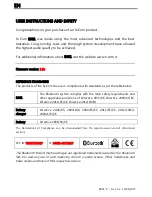
1-2
Cisco Secure Router 520 Series Software Configuration Guide
OL-14210-01
Chapter 1 Basic Router Configuration
Viewing the Default Configuration
Viewing the Default Configuration
When the router first boots up, some basic configuration has already been performed. All of the LAN
and WAN interfaces have been created, console and VTY ports are configured, and the inside interface
for Network Address Translation has been assigned.
To view the default configuration, follow these steps:
Step 1
Use the default username
cisco
and the default password
cisco
to enter the privileged EXEC mode.
Step 2
Use the
show running-config
command to view the initial configuration.
Information Needed for Customizing the Default Parameters
You need to gather some or all of the following information, depending on your planned network
scenario, prior to configuring your network.
•
If you are setting up an Internet connection, gather the following information:
–
Point-to-Point Protocol (PPP) client name that is assigned as your login name
–
PPP authentication type: Challenge Handshake Authentication Protocol (CHAP) or Password
Authentication Protocol (PAP)
–
PPP password to access your Internet service provider (ISP) account
–
DNS server IP address and default gateways
•
If you are setting up a connection to a corporate network, you and the network administrator must
generate and share the following information for the WAN interfaces of the routers:
–
PPP authentication type: CHAP or PAP
–
PPP client name to access the router
–
PPP password to access the router
•
If you are setting up IP routing:
–
Generate the addressing scheme for your IP network.
–
Determine the IP routing parameter information, including IP address, and ATM permanent
virtual circuits (PVCs). These PVC parameters are typically virtual path identifier (VPI), virtual
circuit identifier (VCI), and traffic shaping parameters.
–
Determine the number of PVCs that your service provider has given you, along with their VPIs
and VCIs.
–
For each PVC determine the type of AAL5 encapsulation supported. It can be one of the
following:
AAL5SNAP—This can be either routed RFC 1483 or bridged RFC 1483. For routed RFC 1483,
the service provider must provide you with a static IP address. For bridged RFC 1483, you may
use DHCP to obtain your IP address, or you may obtain a static IP address from your service
provider.
AAL5MUX PPP—With this type of encapsulation, you need to determine the PPP-related
configuration items.
•
If you plan to connect over an ADSL line:
Summary of Contents for 520 Series
Page 15: ...xv Cisco Secure Router 520 Series Software Configuration Guide OL 14210 01 Preface ...
Page 18: ...xviii Cisco Secure Router 520 Series Software Configuration Guide OL 14210 01 Preface ...
Page 19: ...P A R T 1 Getting Started ...
Page 20: ......
Page 33: ...P A R T 2 Configuring Your Router for Ethernet and DSL Access ...
Page 34: ......
Page 103: ...P A R T 3 Configuring Additional Features and Troubleshooting ...
Page 104: ......
Page 123: ...P A R T 4 Reference Information ...
Page 124: ......
Page 162: ...Index IN 8 Cisco Secure Router 520 Series Software Configuration Guide OL 14210 01 ...
















































